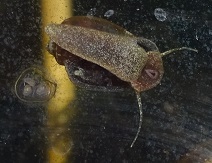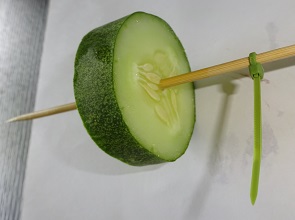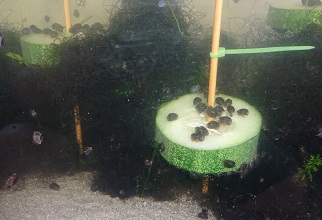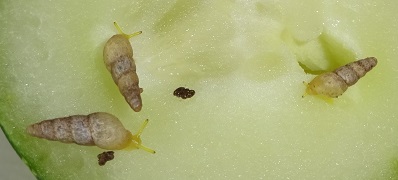| Home | Nature Weekly Index |
8 November 2015 | DIY Snail Bait |
 The snail problem in my small aquarium was getting from bad to worse. There are now
countless of small, dark brown
Aquatic Pulmonate Snail (Amerianna carinata) in there, hiding
among the thick, filamentous algae that had overgrown and covered all the aquatic plants. Many eggs were being deposited along the
4 corners of the tank and under the floating
Frogbit (Hydrocharis morsus-ranae). Though the snails were doing a
good job clearing the algae growing on the surface of the tank, hundreds of them in a small tank is rather unsightly and might
eventually cause a serious imbalance of this small aquatic ecosystem. The
Ramshorn Snail (Gyraulus convexiusculus) that I
shared on 19 July had disappeared. The tank was now dominated by a single snail
species.
The snail problem in my small aquarium was getting from bad to worse. There are now
countless of small, dark brown
Aquatic Pulmonate Snail (Amerianna carinata) in there, hiding
among the thick, filamentous algae that had overgrown and covered all the aquatic plants. Many eggs were being deposited along the
4 corners of the tank and under the floating
Frogbit (Hydrocharis morsus-ranae). Though the snails were doing a
good job clearing the algae growing on the surface of the tank, hundreds of them in a small tank is rather unsightly and might
eventually cause a serious imbalance of this small aquatic ecosystem. The
Ramshorn Snail (Gyraulus convexiusculus) that I
shared on 19 July had disappeared. The tank was now dominated by a single snail
species.
There was no way I could pick them out by hands due to their sheer numbers and small size. After consulting the Internet, on 11 October, I decided to try the cucumber bait which seemed to be the most effective bait based on the information available in the Internet. My first attempt was to hang slices of cucumber by a thin fishing line into the tank. As the cucumber float in water, I tied a weight on the cucumber. The bait was effective but the whole set up was too clumsy. After a few try, I decided to abundant this method. The few DIY methods illustrated in the Internet consist of too much preparation work and not suitable for a small tank.
After several weeks of pondering on an effective and easy way, the idea finally came along yesterday. All I need was a few satay sticks and plastic ties, and of course, the delicious cucumber slice. Step one was to push the satay stick through the middle of the cucumber slide. Next, fasten the plastic tie on the satay stick above the cucumber slide. Finally, push the whole set up into the sand in the tank and keep it upright. The plastic tie kept the bait in the desired position. When sufficient number of the snails gathered on the bait, simply took the whole bait setup out of the water and cleared the snails. Thereafter, put the stick back into the tank for another round of "fishing".



This morning, the routine cleaning of the tank was a breeze. I did not have to spend time fishing out snails manually. As the cucumber may pollute the water, I will be doing it only a day before cleaning the tank.
 With the leftover slices of cucumber, I thought of trying to bait the land snails in my pot as well. Small elongated land snails
were common resident in my pot. Based on the pocket book "A Guide to Snails and other Molluscs of Singapore" published by Singapore
Science Centre in 2012, there are at least 3 similar-looking ones from the family Subulinidae, namely Subulina octona,
Lamellaxis gracilis and Opeas pumilum. The empty shell pictures in the guide book did not offer much help. In a
June 2015 report on a
snail survey conducted at the island of Pulau Tekong,
there were 2 snails from the family Subulinidae mentioned, namely Subulina octona and Paropeas achatinaceum.
Paropeas achatinaceum was noted to be a rare species. Therefore, I had deduced the identity of the small snail in my pot as
Miniature Awlsnail (Subulina octona).
With the leftover slices of cucumber, I thought of trying to bait the land snails in my pot as well. Small elongated land snails
were common resident in my pot. Based on the pocket book "A Guide to Snails and other Molluscs of Singapore" published by Singapore
Science Centre in 2012, there are at least 3 similar-looking ones from the family Subulinidae, namely Subulina octona,
Lamellaxis gracilis and Opeas pumilum. The empty shell pictures in the guide book did not offer much help. In a
June 2015 report on a
snail survey conducted at the island of Pulau Tekong,
there were 2 snails from the family Subulinidae mentioned, namely Subulina octona and Paropeas achatinaceum.
Paropeas achatinaceum was noted to be a rare species. Therefore, I had deduced the identity of the small snail in my pot as
Miniature Awlsnail (Subulina octona).
Several of the snails did crawl under the sliced cucumber placed in the pots. The numbers were very small compared to that from the tank. I had always wanted to take some pictures of this snail but the size of the snail made it rather difficult to take a good picture. Having the snail on the cucumber eliminated this obstacle. Now, I was able to snap pictures of the snails at ease. Nevertheless, taking picture of the baby snails was still a big challenge.